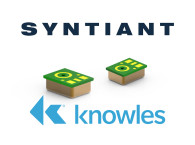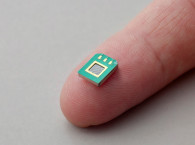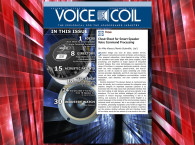
Yet, as with any innovation, the greater the step forward, the greater the challenges to design wins. Let's take a look at why product designers have been reticent to embrace smart mics.
Today's product architectures have the signal processing further down the line - not at the mic. Smart mics are still just entering the market, with some coming from small start-ups without a second source - a high-risk design and purchasing decision.
The footprint of most MEMs mics follows the small industry-standard 3.76 mm x 2.95 mm x 1.3 mm package. Yet when packing more elements inside the interior of the SMT package, the air volume is reduced - and as this back volume shrinks, so does signal to noise. Vesper was in development of a superior doping process for their piezo MEMS mics to increase the signal to noise ratio - which was just in the nick of time to maintain performance of their latest VM3011.

The Vesper VM3011 is targeted for some of the same applications as the Knowles IA61x family of "wake-on-voice" SmartMics. Knowles uses a 43 MHz Tensilica audio-optimized DSP in their SiSonic MEMS mic in a single, miniature, microphone package - the AISonic SmartMics family. The integrated programmable DSP was made available to third-party algorithms, enabling customization.
The VM3011 is intended for the low-power always-listening device market. Vesper's Adaptive ZeroPower Listening (ZPL) technology automatically "learns" the acoustic characteristics of the environment in real-time, ignoring background noise and only wakes in response to keywords or other desired acoustic triggers. By automatically adjusting the background threshold based on the acoustic level of the environment, this allows the system to hibernate over 90% of the time and extend battery life >10x. The VM3011 is a bottom port IP57 device, resistant to dust and moisture and can tolerate high acoustic levels without latch-up or mic element overload. When combined with the ultra-fast startup of piezo microphones, the VM3011 enables system power savings for voice-activated devices without compromising the acoustic performance.
The microphone is constantly listening to the environment with 10 μA of current consumption. In Wake on Sound (WoS) mode, a Digital Output pin (DOUT) outputs a single bit "Threshold Exceeded" flag when the acoustic input is greater than the set threshold. When the threshold is reached, an interrupt signal is sent to the external codec or voice processor - which "lights-up" anything and everything for a prescribed time frame. Adaptive Mode continuously measures the average sound level of the environment and adjusts the internal comparator until it converges to the threshold margin.
Matt Crowley, CEO of Vesper mentioned in a briefing with audioXpress that this technology "will power a new class of products such as always-listening far-field TVs, always-listening smartwatches, home security cameras and doorbells and many other system." It is available in volume production by Q4 2020, in a small industry-standard 3.76 mm x 2.95 mm x 1.3 mm package, and it's reflow solder compatible.

Nanusens has announced that nano-sensors built inside CMOS devices can increase the operational life of true wireless stereo (TWS) earbuds by up to 20%. Instead of the conventional 2 chip MEMS sensor package (one with the MEMS structure built on it and the second with the control electronics), Nanusens has everything on one chip and with this technology various sensors in an earbud can be replaced with a single multi-sensor chip that is up to ten times smaller, freeing up space for larger batteries. Nanusens creates its sensors within the control chip layers of its CMOS chip. The nanoscale of this technology delivers ultra-low power consumption.
The first product from Nanusens is a 2D motion detector for TWS earbuds to implement tap and double tap for control, wake-on-movement and sleep-on-rest functions with an optional 3D accelerometer. Also coming is a bone conduction sensor for noise cancellation integrated into their single chip solution.
Syntiant's ultra-low-power Neural Decision Processors for Always-On Voice (AOV) control offers accurate wake word, command word and event detection in a tiny package with near-zero power consumption. Voice is quickly becoming the de facto standard user interface as hands-free functionality is replacing traditional tactile interfaces. Banging on your ear for mode toggling with TWS devices was awkward, but these days keeping your hands from touching your head (or anything) is a whole other consideration. Access to the cloud is not needed so the user can be in a dead zone, but also latency is minuscule. The ASIC is tiny and it is possible to integrate it into TWS or future SoC Bluetooth TWS solutions.
A smart mic with integrated voice command has wide applications. For sure these building blocks will converge into smaller, smarter and longer battery life mobile audio products.

For continuous updates on these topics, follow audioXpress online Select Pages:
Voice Recognition
Smart Speakers
Wireless Earbuds
This article was originally published in The Audio Voice newsletter 289.








